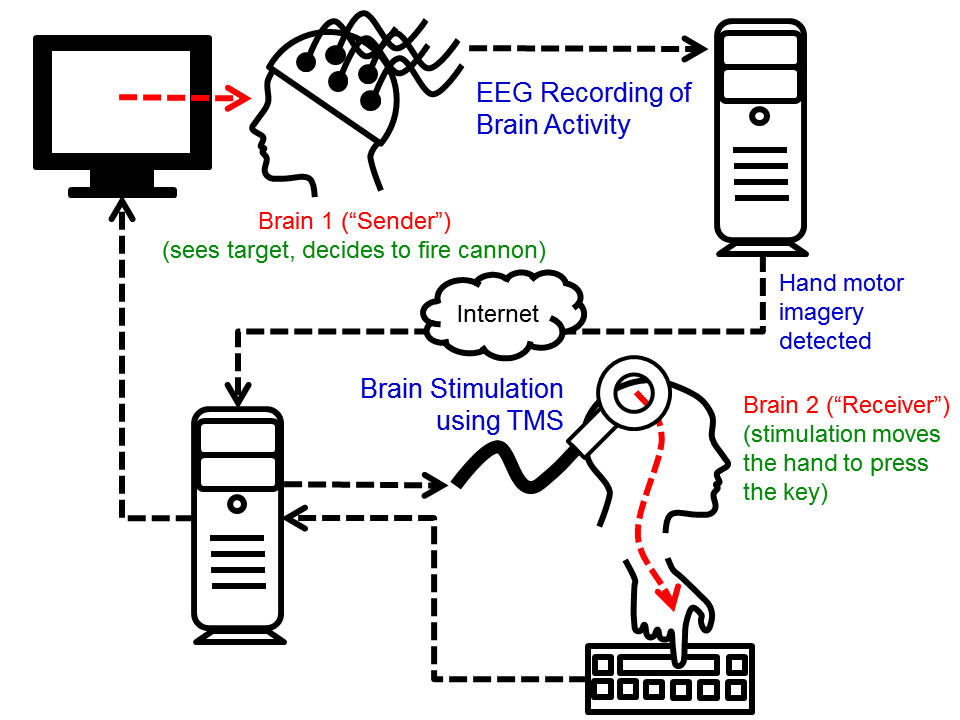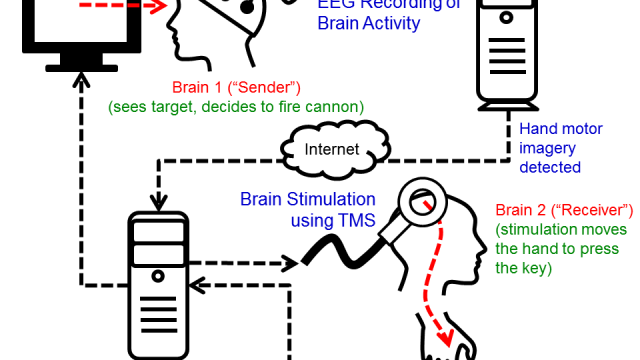Sit down for this one. Researchers at the University of Washington have figured out how to send commands from one person’s brain to control a different person’s muscle movement. In technical terms, it’s the world’s first noninvasive human-to-human brain interface. How’d they do it? Vulcan mind meld? Nope, just the regular ol’ internet. What in the hell?
Here’s how it went down: In one building, computational neuroscientist Rajesh Rao sat wearing an electroencephalography cap, which measures the brain’s electrical activity. Dr Rao watched a simple computer game, firing a cannon at a target. At the right moment, Dr Rao imagined moving his right hand to hit the “fire” button, being sure not to actually move his hand.
Across campus, Dr Rao’s colleague, Professor Andrea Stocco, wore a cap holding a transcranial magnetic stimulation coil, which sits on the scalp and stimulates muscle control regions of the brain with a magnetic impulse. He wore noise-blocking earplugs and faced away from the video screen. Signals sent from Dr Rao’s cap traveled through the internet and trigger Dr Stocco’s cap. The result? Dr Stocco’s finger hit the “fire” button on Dr Rao’s command.
As sci-fi bizarro as this sounds, the whole setup basically used off-the-shelf components. The electroencephalogram cap that picked up the brain activity, and the transcranial coil that transmitted it, have been deployed in scientific experiments for years, and the internet’s not exactly a recent innovation either. But while researchers have performed brain-to-brain communication between rats and from a human to a rat, the University of Washington team claims this is the first human-to-human brain interface.

Don’t worry though; your visions of this being used for nefarious plots are probably highly overblown. Dr Rao points out that this technique only reads muscle signals, not thoughts, and it can’t make you move against your will. And as Dr Stocco points out, it’d be pretty hard to use this on someone covertly, what with all the apparatus they’d have to wear:
“I think some people will be unnerved by this because they will overestimate the technology. There’s no possible way the technology that we have could be used on a person unknowingly or without their willing participation.”
That’s reassuring, but the uses they envision for this technique are by no means modest. Dr Stocco says it could someday be used to by a pilot on the ground to help a passenger land an aircraft (bet you never thought of Aeroplane! as a look into the future of brain research). Even better, it could help immobile patients, like those suffering from locked-in syndrome, express themselves physically. Muscle movement has no language barrier.
The next step for the research team is attempting to transmit more complex information brain-to-brain. That’s when we’ll really be getting into Matrix-style stuff. At least now you’ve got plenty of time to decide if you want the red or blue pill. [University of Washington]
Picture: University of Washington
